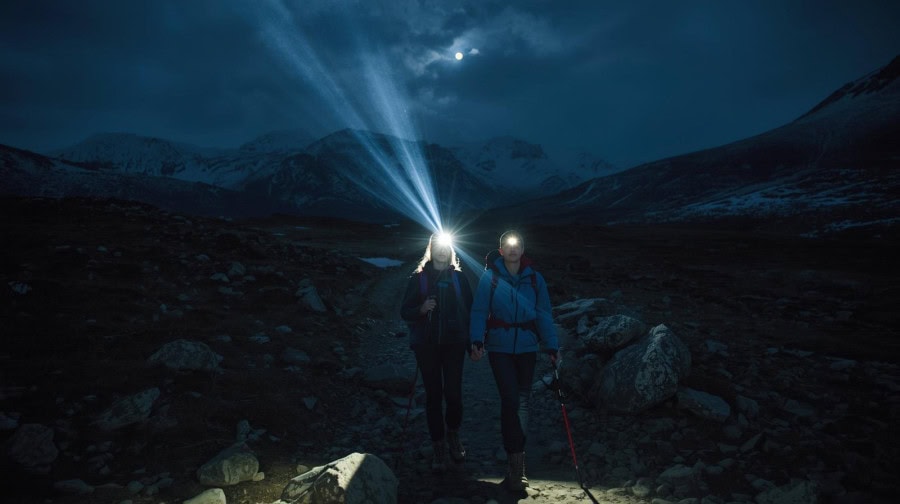Table of Contents
Some links on posts are affiliate links and will earn us a commission from qualifying purchases
You know that moment in winter when you glance at your watch and it’s only 3:30 p.m., yet the sky has already gone that moody shade of navy blue? Yep – that’s your cue to start walking a bit faster.
Winter hiking in the UK isn’t just about mud and woolly hats, it’s about mastering the fine art of racing the sunset.
But don’t panic – with a bit of planning (and a good headtorch), you can make winter hiking just as fun as those endless summer rambles.
Why daylight is so short in UK winters
If you’ve ever wondered why it feels like the sun sets halfway through your lunch, it’s simply because it almost does. In December, the UK enjoys a generous 7-8 hours of daylight – and by daylight, we mean a slightly dim, watery sort of light that could pass for early evening in Spain.
In northern Scotland, or when you’re on high ground or in deep valleys, that usable light can feel even less. The sun rises late, sets early, and creeps across low in the sky, making shadows longer and visibility worse. Clouds and overcast skies, which we get a lot, don’t help. If you’re hiking in winter, the clock isn’t just ticking – it’s sprinting.
Planning routes around daylight hours
This is where the magic word “planning” comes in. Forget those 15-mile epics you smash out in July – winter is the season of modest ambition. Aim for routes that you can comfortably complete in 4-5 hours, leaving yourself some wiggle room for tea breaks, photo stops, faffing about with gaiters, maybe even a wrong turn or two.
Check sunrise and sunset times using reliable sources (Met Office, apps like Weather, or hiking-specific apps). Plan your start early so you’re out of daylight by the time you expect to finish.
Also, always have a fallback: a shorter route or a point you can cut up if dusk is coming faster than expected. If you’re hiking somewhere you don’t know well, make sure someone knows which route you took and roughly when you expect to be back.
Headtorch essentials – lumens, batteries, spares, plus what’s new
A good headtorch in winter isn’t optional – it’s your ticket home. Here’s what to look for, and some current options on Amazon UK.
What to look for:
- Lumens: Aim for at least 200 lumens for general hiking. If you’ll be in open, dark terrain or expect to walk in cold moons, 300-500 lumens gives better throw. If you just need to see immediately in front of you (paths, markers), a lower setting plus red light mode is helpful (red preserves night vision).
- Battery type & runtime: Rechargeable or battery-powered? Both have pros and cons. Rechargeables (USB-C etc.) are convenient but ensure you can charge or have a power bank. Traditional AA/AAA types are bulkier but easier to replace in the field. Know how long your torch lasts on each setting.
- Spare batteries / backup torch: Always pack spares. A backup is not overkill.
- Weather & durability: Waterproof or at least water-resistant; good strap; something that can take knocks.
And yes, I once forgot mine entirely and ended up following a friend’s bobbing headtorch like a very cold, slightly grumpy sheep. Lesson learned.
Recent good headtorch options on Amazon UK:
I browsed what’s available currently; here are some good ones to consider (prices vary):
- LED Lenser head torches – their range include high lumen models with good IP ratings. For example, “Ledlenser H19R Signature” is super bright, waterproof (IP68), and has decent swivel lamp head features.
- “2000L Waterproof LED Headlamp with Red Warning Lights, 6 Lighting Modes” – these types are great all-rounders: powerful for when you need them, modes so you can drop brightness, red warning lights help with visibility to others/warning.
- Smiling Shark LED Headlamp – I saw a wide angle headlamp, rechargeable, motion sensor, waterproof. Good for short winter hikes where you want a flood-type beam to see lots of ground close to you (roots, loose stones etc.).
When you pick one, think: will it be comfortable on your head with a hat or hood on? Will the weight and battery last the dark stretch you expect to be walking in?
Gloves – what to wear, and Amazon UK suggestions
Hands are often the first to suffer when winter hits. Fingers stiffen, gloves get wet, dexterity suffers. Here’s the strategy:
- Layer up: Use inner (liner) gloves for dexterity, then a thicker or waterproof outer glove for warmth and protection.
- Waterproof / windproof shell: Even a small wind will steal heat. A glove that blocks wind or sheds moisture makes a big difference.
- Touchscreen compatibility: Handy for maps, phones etc without exposing raw fingers.
- Fit: Not too tight (to allow circulation), not too loose (so warmth doesn’t escape).
Amazon UK glove suggestions:
Here are gloves currently available that many hikers might find helpful:
- Thermal Winter Gloves, Touchscreen Compatible, Windproof Anti-Slip – a general-purpose glove, good for hikes when it’s cold but not storming.
- Waterproof & Windproof Winter Gloves for Men and Women, 3M Thinsulate – for colder, wetter hikes; insulated, helps keep moisture out. Amazon UK+1
- Warm Winter Gloves, Windproof Water-Resistant, Anti-Slip Thermal Gloves – especially useful if you use poles or have to grip wet rocks, or when surfaces are slippery.
- Lightweight Hiking/Running Gloves with Touchscreen Fingers – for shorter walks, twilight rather than pitch dark; good if you want something more dexterous.
Also, don’t forget a spare pair of gloves in your rucksack in case the main pair gets soaked (through river crossings, heavy rain etc).
Mindset shifts – enjoying shorter hikes and embracing night walking
Winter hiking doesn’t have to mean missing out – it just means doing things differently. Embrace the shorter walks, the slow pace, and the cosy post-hike pub visits. Think of it as quality over quantity.
Night walking? It can be surprisingly magical. Trails you know well feel completely new; stars, moonlight on frost, the hush of landscape in dusk. If you walk with others, there’s camaraderie in stumbling over roots together. If you walk solo, there’s brain space for quiet reflection. Just make sure you’ve got that headtorch and maybe a friend to share the spookiness – unless you enjoy convincing yourself that every snapping twig is a werewolf.
One mindset trick: treat dusk not as an imposition, but as a feature. Enjoy the colours, the long shadows, the lull in activity. Also, accept that sometimes you’ll finish in partial darkness – plan for it, accept it, and savour it.
Safety considerations – cold, fatigue, navigation
Winter isn’t out to get you, but it will happily catch you off guard.
- Cold: Dress in layers; base/layers that manage moisture (don’t let sweat freeze); insulated mid-layers; good outer shell. Warm hat, spare hat, warm gloves, maybe liners. Wet gloves are almost worse than none.
- Fatigue: Cold makes muscles stiff, slows you down, costs energy. Eat calorie-rich snacks, drink enough (you’ll sweat, even if you don’t feel like it). Rest more often than in summer.
- Navigation: Visibility drops fast. Fog, snow or low light complicates things. Map & compass still matter. Phone GPS is a bonus, but don’t rely solely on it: battery life is worse in cold; screens are harder to see; electronics can fail.
- Emergency gear: Think about carrying a foil blanket or bivvy bag, extra layers, maybe an emergency light, whistle. Let someone know your route and your expected return time.
Conclusion: winter hiking is magical — if you respect the clock
Winter hiking can be brilliant – empty trails, crisp air, frost on branches, that quiet feeling you only get when the day is winding down. But it’s also a game of beating the sunset, so treat daylight as a precious resource and plan accordingly.
With good gear (torch, gloves, layers), a mindset shift (embracing the shorter hikes, enjoying night walking), and respect for safety, winter hiking isn’t just manageable – it can be some of the most magical hiking of the year.
Trust me: when you finish a winter walk right as the sky turns pink, you’ll feel like you’ve outsmarted nature itself. And if you do find yourself walking the last mile by torchlight, just remember – that’s also part of the story you’ll tell later over a hot chocolate (extra marshmallows optional).
Recent Posts
When you're out walking in the great outdoors, there’s a simple pleasure in leaving your phone in your backpack and letting nature guide you. But as the afternoon stretches on and the sun begins to...
Winter Hiking Tips: Embrace the Colder Months with Confidence
Winter hiking offers a captivating opportunity to explore nature's frozen beauty, presenting a unique experience with snow-draped landscapes, frosted peaks, and serene woodlands. In this...



